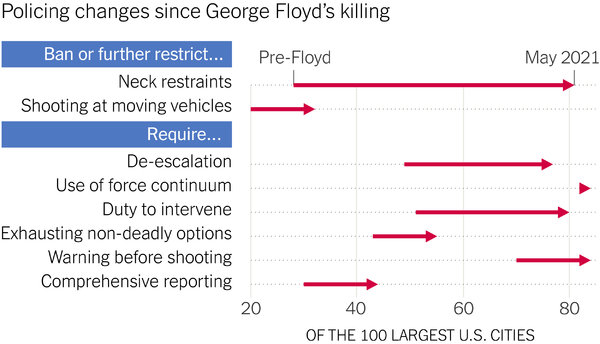Home »
» New York Times: New Rules for Police
More than 30 states
and dozens of large cities have created new rules limiting police
tactics. Two common changes: banning neck restraints, like the kind
Chauvin used; and requiring police officers to intervene when a fellow
officer uses extreme force. |
 | | By The New York Times | Source: Campaign Zero |
|
Most
of the states and cities passing these laws are run by Democrats, but
not all. Kentucky, Indiana and Iowa have done so, too. At the federal
level, the House has passed a bill named for Floyd that would limit
police use of force and make it easier to prosecute officers for
wrongdoing. The Senate has not passed any policing bill. |
Christy
Lopez of the Innovative Policing Program at Georgetown University calls
the changes important but preliminary: “They’re really necessary first
steps, but they’re also baby steps,” she said. |
The
Black Lives Matter movement — which was re-energized by the killings of
Floyd, Breonna Taylor and others — has called for changes to much more
than policing. The movement has demanded that the country confront its
structural racism. |
In
response, many companies and institutions have promised to act. The
National Football League apologized for past behavior. NASCAR banned the
Confederate flag from its events. McDonald’s, Amazon and other
companies pledged to hire more diverse workforces. |
“Non-Black
employees joined with their Black colleagues to demand the hiring of
more Black people,” The Washington Post’s Perry Bacon Jr. wrote. “So companies and institutions stopped whining about supposedly bad pipelines and started looking beyond them.” |
It’s still unclear how much has changed and how much of the corporate response was public relations. |
3. Changes in public opinion |
Initially,
public sympathy for the Black Lives Matter movement soared. But as with
most high-profile political subjects in the 21st-century U.S., opinion
soon polarized along partisan lines. |
Today, Republican voters are less sympathetic to Black Lives Matter than they were a year ago, the political scientists Jennifer Chudy and Hakeem Jefferson have shown. Support among Democrats remains higher than it was before Floyd’s death but is lower than immediately afterward. |







0 comments:
Post a Comment